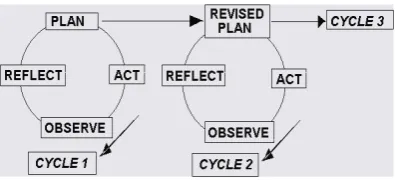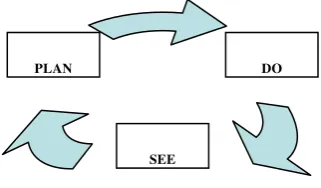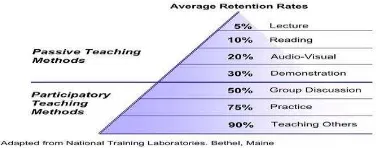PROSIDING ICTTE
FKIP UNS 2015
ISSN: 2502-4124
Vol 1, Nomor 1, Januari 2016
Halaman:
| 586
Building Collaborative Learning Through Lesson Study
Triyanto
Civic Education Dept., Faculty of Education, Sebelas Maret University Jl. Ir. Sutami 36A, Surakarta, Central Java, Indonesia
Corresponding e-mail: [email protected]
Abstract: Education in Indonesia is still experiencing a variety of complex problems. One problem is the poor quality of teaching. The low quality of learning is caused by lack of development system of quality learning in the classroom. Collaborative learning through lesson study can be a solution to improve the quality of learning in the classroom. This article discusses how to build a strategy of collaborative learning through lesson study. Teachers will work together and discuss and find solutions of problems in the classroom. Collaborative learning can improve the quality of learning and strengthen collegiality among teachers.
Keywords: Building, Collaborative Learning, Lesson Study
1 INTRODUCTION
Education in Indonesia still faces many problems. One main problem is about the quality of learning. The low quality of teaching is due to a lack of learning quality development program. The main problem is the low learning collaborative learning.
Low collaborative culture led to uneven quality of education. There are outstanding students but also less intelligent. There is no cooperation between smart and dumb students. Thus, the quality of education in general is low.
A collaborative culture among teachers is also low. Teachers rarely discuss with other teachers to discuss teaching issues. Teachers work alone in facing the problem of learning. Therefore, learning problems cannot be resolved properly (Triyanto, 2015).
Lesson study is one of program to improve collaborative learning. Lesson study is a quality teacher development programs through collaborative work between teachers and stakeholders. In lesson study, teachers communicate and cooperate with each other to solve problems in the classroom. Communication and cooperation between teachers can effectively help solve learning problems.
Lesson study is a tool to form a learning community. School in the 21st century is a school that implements learning community (Sato, 2012). Learning community can support school reform program. This paper discusses how the lesson study can foster a culture of collaborative learning.
2 METHODS
This article is the result of a classroom action research. Action research methods were proposed by Kurt Lewin in 1946. The research location is Vocational High School (SMK N) 1 Banyudono. The study involved three teachers and three students internships. The steps of action research are (1) Plan, (2) Act, (3) Observe, and, (4) Reflect. The steps are cyclical.
Figure 1. Cycle of classroom action research (Riding, Fowell and Levy, 1995)
3.
DISCUSSIONS
3.1. Definition of Lesson Study
Terms lesson study is still relatively alien among the majority of teachers in Indonesia. Indeed, lesson study has long been grown in Japan, which is about century-19.Lesson study began to be developed in Indonesia around the end of 2004, sponsored by JICA (Japan International Cooperation Agency).
Lesson study is a systematic process used by teachers in Japan to test the effectiveness of teaching in order to improve learning outcomes (Garfield, 2006). Teachers collaboratively and continuously develop lesson plans, observation, reflection and revision of lesson plans. According to Walker (2005), Lesson study is a method of professional development of teachers. According to Lewis (2002), the idea of lesson study is short and simple, that is, if a teacher wants to improve learning, one of the most obvious ways is to collaborate with other teachers to design, observe and reflect on the lessons.
PROSIDING ICTTE
FKIP UNS 2015
ISSN: 2502-4124
Vol 1, Nomor 1, Januari 2016
Halaman:
| 587
DO
SEE PLAN
3.2 Steps of Lesson Study
There are three main phases of lesson study, namely: (1) Plan, (2) Do, and (3) See (Saito, 2005). The three stages are carried out repeatedly and continuously (cycle).
Figure 2. Cycle of lesson study (Saito, 2005).
The planning stage (PLAN) aims to create a lesson plan that is believed to be able to teach students effectively and generate active participation of learners in learning. Good planning cannot be done alone. At this stage, some educators can collaborate to enrich the learning design ideas that will be generated, covering aspects of the organization of teaching materials, pedagogical aspects, and aspects of the preparation of teaching aids. Before the final results, we need to test all the components contained in the lesson plan. At this stage, we also need to establish guidelines for observation, including the necessary instruments.
Implementation stage (DO) is intended to implement a lesson plan that has been formulated in the previous stage. One member (teacher / lecturer) acts as a "model teacher", while others act as observers (observer). Other observers (other than members of the planning group) can also act as an observer. The observations focused on the activities of learners based on the observation of procedures and instruments that have been agreed at the planning stage, is not to evaluate the performance of teachers (lecturers) who was in charge of teaching. During the learning takes place, observers should not interfere or intervene in the learning activities. Observers can also perform recording learning activities via video camera or digital photos for documentation purposes and or discussion at a later stage, or even for research activities. In addition to collecting information, the observer's presence in the classroom is also intended to learn from the ongoing study.
Stage reflection (SEE) is intended to discover the advantages and disadvantages implementation of learning. Teachers or lecturers models initiate discussions with the impression conveyed in implementing the learning. The next opportunity is given to members of the observer group. Furthermore, outside observers are requested to submit comments and lessons learned from learning
especially with respect to the activities of learners. Criticisms and suggestions submitted wisely without degrading or hurting a teacher for the sake of improvement. Conversely, those who criticized should be able to receive input from the observer to the next learning improvement. Based on input from these discussions can be redesigned next bettter learning.
3.3. Why Collaborative?
Collaborative learning plays an important role for creating quality learning. The purpose of the collaborative learning is to ensure all students acquire the same quality of learning.
The main issue in learning in Indonesia is low collaborative culture. Teachers rarely communicate with each other to discuss problems in the classroom. Collaborative culture among the students in the class is also not strong. Students learn the group but not all groups do collaborative work (Triyanto, 2015).
Education in Indonesia still has a competitive culture. This causes uneven student achievement. There is a very smart student, but there are students who are very stupid. Even the best Indonesian students can compete or even smarter than students from developed countries. However, the numbers of the best students are not much. So that despite Indonesia having the best students, but the quality of education in general is still not good. This is in contrast to developed countries with more equal quality students. That's why we need to build a culture of collaborative learning.
Nowdays, Japan as a developed countries are trying to apply collaborative learning (Kitada, 2015). But collaborative learning is not just learning groups because the group is not always working collaboratively. Work independently within a group cannot be called a collaborative work.
Collaborative learning will ensure cooperation among students in learning. Among the students help each other solve problems lesson. Smart students helping students ignorant and stupid student asks for help to the students smart. So, all students have equal capabilities. Finally, the quality of education in general increases.
3.4. Building Collaborative Work
To make collaborative learning, there are four steps: planning, implementation, observation, and reflection. This stage is the cycle. If the reflection found lacking, then the cycle can be repeated.
3.4.1. Planning
PROSIDING ICTTE
FKIP UNS 2015
ISSN: 2502-4124
Vol 1, Nomor 1, Januari 2016
Halaman:
| 588
that collaborative learning plays an important role inimproving student performance collectively.
There are several models of collaborative learning. Discussion decided to use a model of teaching others. Based on research from the National Training Laboratories, Bethel, Maine, stated that teaching others is the most effective models for improving the quality of learning.
Teaching others is one form of participatory teaching method. The essence of this method is the peer teaching among students. Smart student teach students stupid and stupid students learn to smart students. Thus the quality of the learning will be equivalent.
Figure 3. Learning Piramid
3.4.2. Implementation and Observation Classes are divided into small groups. Initially there were six students per group. However, the number of 6 students per group is not effective. The results of discussions between the model teacher and observer decided to change into a group of 4 students. Number four students per group are ideal. If possible, each group of students there are 2 male and 2 female students.
Implementation and observation adopted the model of lesson study. Model teacher do open class attended by observers. The learning process was observed by observer with the following guidelines: 1) Observing the student, not the teacher. It is
intended that the teacher model is not shy. 2) Finding the facts in the class
3) Forbidden to interfere or intervene the learning After delivering brief of material, teacher gives the task to each group. All students in a group discuss the task. Teacher ensures that all member of group participate in discussion. Teacher endorses the stupid student to ask to the clever student. Endorsing stupid student to ask the clever student is more effective to keep the knowledge than asking the clever student teaching the stupid student. Teaching others can also be called as peer-teaching model of learning. 3.4.3. Reflection
Reflection is needed to discuss the finding from observation. It is recommended to held reflection after open class directly. Reflection after open class is very helpful to keep the memory of the finding in observation.
Observer can share all finding reflection discussion with the guidance as follows:
1) Saying thank you to the model of teacher; 2) It is forbidden to judge the model of teacher; 3) Discussing the student, not the teacher; 4) Giving credit point to the model of teacher; 5) Hearing more
6) Sharing the fact by mentioning the student; 7) Sharing lesson-learned found from observation;
and
8) Sharing the suggestion or improvement based on self experience.
4. CONCLUSIONS
Based on the background and discussion, it can be concluded that collaborative learning plays in a vital role to improve the quality of learning. Lesson study is the way to build the collaborative culture. The essence of collaborative learning is communication among teachers and among students. Communication is very important process to solve the problems of learning.
5. ACKNOWLEDGEMENTS
We thank you for Japan International Corporation Agency (JICA) and Ministry of Education for sponsoring Training on Lesson Study in Japan (May -June 2015). The training is very inspiring the content of this article.
6. REFERENCES
Garfield, J. (2006). Exploring the Impact of Lesson study on
Developing Effective Statistics Curriculum, (Online),
(www.stat.auckland.ac.nz/-iase/ publications/11/- Garfield.doc, diakses 19 Juni 2006.
Ibrohim. (2010). Panduan Pelaksanaan Lesson Study di KKG.
Malang: Universitas Negeri Malang.
Lewis, C.C. (2002). Lesson study: A Handbook of Teacher-Led
Instructional Change. Philadelphia: Reseach For better
School .Inc.
Manabu Sato. (2012). Mereformasi Sekolah: Konsep dan Praktik
Komunitas Belajar. Tokyo: JICA
Phil Riding, Sue Fowell and Phil Levy. (1995). An action research approach to curriculum development. Information Research, Vol. 1 No. 1, April 1995.
Saito, E., (2005). Changing Lessons, Changing Learning: Case
Study of Piloting Activities under IMSTEP. Prosiding
Seminar Nasional MIPA dan Pembelajarannya & Exchange Experience of IMSTEP. Malang, 5-6 September.
Triyanto. (2015). Implementasi Lesson Study di SMKN 1
Banyudono. Laporan penelitian lesson study. Surakarta:
FKIP UNS.
Walker, J.S. (2005). UWEC Math Dept. Journal of Lesson Studies. (Online),
www.uwec.edu/walkerjs/Lesson_Study/Statement_of_Purp ose.pdf., diakses 26 Oktober 2006.


